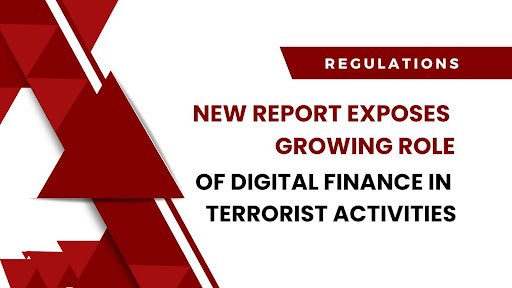The wave of technological advancement in the financial sector is altering the dynamics of terrorist financing. According to recent reports and regulatory updates, cryptocurrencies and fintech platforms are being manipulated by terrorist groups.
This is even happening with the efforts of global authorities to implement strong anti-money laundering and counter-terrorism financing(CFT) measures.
A Crypto Crime Report of 2025 by TRM Labs features that the illicit crypto activity fell by 24% in 2024. As digital assets expand, terrorist financing is going through its shift. This is a growing concern among financial institutions and organizations about storing and moving their funds.
Digital assets include cryptocurrencies and stablecoins. They offer new freeways for illegal activities and actors to bypass traditional financial controls.
The report highlights that blockchain anonymity, its speed, and reach make it more attractive for people seeking to avoid detection. Despite the fall in some crypto-enabled crimes, ransomware payments are new and growing activity in terrorist financing.
This situation indicates that criminals are adopting new ways more quickly with the technological changes.
Regulators are responding to a mixture of new regulations around the world. They are enhancing the enforcement and technological innovations.
The regulatory environment is transforming with greater clarity, transparency, and support for cryptocurrencies in the United States. However, there is increased emphasis on compliance and risk management. In Trump’s administration, executive orders and congressional actions are planned.
They plan to define more legal frameworks for digital assets. The particular areas of more defined frameworks include stablecoins. Stablecoins are used more often in cross-border payments for illicit finance.
The Financial Action Task Force (FATF) warns of global compliance and its standards for virtual assets. It is still patchy, and 75% of governments are partially compliant or not compliant at all.
The regulatory gap leaves room for terrorist groups to manipulate the weak points of the global financial system. The target countries are those that do not have the implementation or priorization of the implementation of AML/CFT measures for digital assets.
The U.S. Office of the Comptroller of the Currency (OCC) is the regulatory provider of the new guidelines. These guidelines include instructions on banks’ engagement with crypto activities to remove the barriers to innovation.
In March 2025, the OCC’s Interpretive Letter 1183 was issued to eliminate the need for prior supervisory approval for certain crypto-related activities. It highlights the signals of growing acceptance of digital assets within the banking sector.
The growing incorporation of crypto and traditional finance raises interest in effective compliance and risk management strategies.
Enforcement authorities prioritize the detection and investigation of illicit crypto flows. This includes terrorist financing and avoidance of sanctions.
Different countries, including the U.S., the UK, and the EU, are using sanctions as a tool to pressure invaders. However, regulators are looking for crypto firms to implement AML programs that operate beyond the traditional framework of know-your-customer (KYC).
Blockchain tools are relied on to be part of effective compliance programs. These programs enable the monitoring of transitions across the entire crypto ecosystem beyond its own platform.
The increasing use of decentralized finance (DeFi) platforms enhances technological privacy and poses additional challenges. Regulators are expanding their operations to deal with DeFi protocols.
It can operate without centralized mediators and fall outside the existing regulatory frameworks. FATF and IOSCO are global standard setters. They have contributed to recommendations for regulating DeFi. The implementation of the recommendations remains inconsistent.
Stablecoins are a growing segment in the crypto market and are under scrutiny. Detailed implementation of legislation is expected in the U.S this year. The aim is to ensure transparency and fully backed, subjective, rigorous oversight.
This will reduce the systematic risk and prevent the stablecoins from being used for illicit finance and terrorist activities.
With all the efforts made, gaps remain. The TRM Labs report, along with other analysts, warns the authorities about the closure of traditional avenues for terrorist financing.
Illegal activities become more realistic when using digital assets. The nature of crypto markets means the weak regulatory authorities in parts of the country. It has severe consequences, and funds can be moved more quickly and anonymously across borders.
Authorities are concerned about the state-sponsored actors’ fraudulent nations using crypto sanctions to avoid illicit purposes. North Korea was involved in hacks, resulting in the theft of $800 million in 2024. This highlights the scale of sophisticated operations involved.
Regulators are pushing international cooperation and adoption of standards in response to these activities. The FATF’s “Travel Rule requires crypto exchanges to share the recipient information for transfer.
This will bring crypto transactions in line with the government and traditional bank transfer standards. The global adoption of these standards is in progress.
The merging of crypto into mainstream finance is expanding. The governments are launching pilot programs for blockchain securities. This trend is expanding, and crypto-based products are becoming common in regulated financial markets.
Market participants are actively strengthening their compliance programs. This makes the use of technology in the detection and mitigation of financial crimes.
Regulators expect blockchain and crypto firms to use advanced tools to monitor transitions. The recent enforcement of actions highlights the importance of risk management.
Crypto and fintech firms are driving innovation for financial inclusion. They are shaping the risk and methods associated with terrorist financing. The report concludes with a warning stating, “If left rampant, the misuse of digital finance could become the primary enabler of global terrorism, overtaking traditional hawala systems and cash smuggling.”
Also Read:













+ There are no comments
Add yours